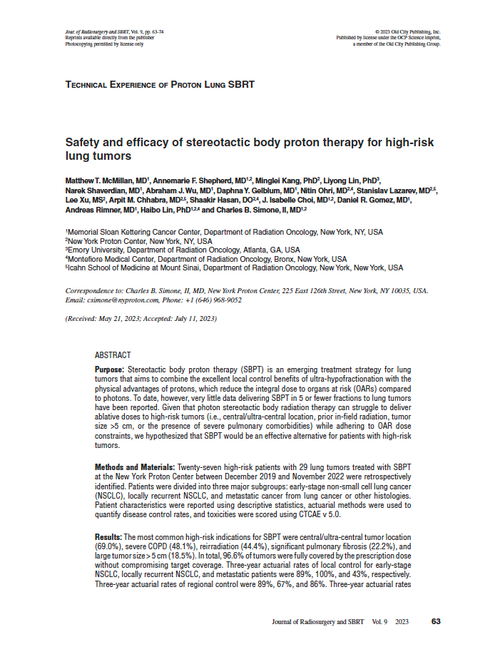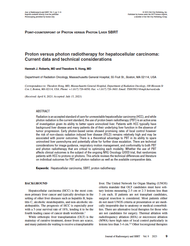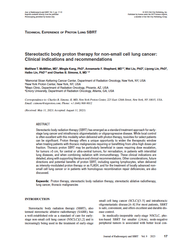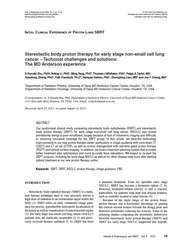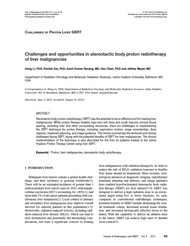- Home
- Journal Contents Downloads
- JRSBRT Downloads
- JRSBRT 9.1, p. 63-74
Product Description
Technical Experience of Proton Lung SBRT
Safety and efficacy of stereotactic body proton therapy for high-risk lung tumors
Matthew T. McMillan, Annemarie F. Shepherd, Minglei Kang, Liyong Lin, Narek Shaverdian, Abraham J. Wu, Daphna Y. Gelblum, Nitin Ohri, Stanislav Lazarev, Lee Xu, Arpit M. Chhabra, Shaakir Hasan, J. Isabelle Choi, Daniel R. Gomez, Andreas Rimner, Haibo Lin and Charles B. Simone, II
Purpose: Stereotactic body proton therapy (SBPT) is an emerging treatment strategy for lung tumors that aims to combine the excellent local control benefits of ultra-hypofractionation with the physical advantages of protons, which reduce the integral dose to organs at risk (OARs) compared to photons. To date, however, very little data delivering SBPT in 5 or fewer fractions to lung tumors have been reported. Given that photon stereotactic body radiation therapy can struggle to deliver ablative doses to high-risk tumors (i.e., central/ultra-central location, prior in-field radiation, tumor size >5 cm, or the presence of severe pulmonary comorbidities) while adhering to OAR dose constraints, we hypothesized that SBPT would be an effective alternative for patients with high-risk tumors.
Methods and Materials: Twenty-seven high-risk patients with 29 lung tumors treated with SBPT at the New York Proton Center between December 2019 and November 2022 were retrospectively identified. Patients were divided into three major subgroups: early-stage non-small cell lung cancer (NSCLC), locally recurrent NSCLC, and metastatic cancer from lung cancer or other histologies. Patient characteristics were reported using descriptive statistics, actuarial methods were used to quantify disease control rates, and toxicities were scored using CTCAE v 5.0.
Results: The most common high-risk indications for SBPT were central/ultra-central tumor location (69.0%), severe COPD (48.1%), reirradiation (44.4%), significant pulmonary fibrosis (22.2%), and large tumor size > 5 cm (18.5%). In total, 96.6% of tumors were fully covered by the prescription dose without compromising target coverage. Three-year actuarial rates of local control for early-stage NSCLC, locally recurrent NSCLC, and metastatic patients were 89%, 100%, and 43%, respectively. Three-year actuarial rates of regional control were 89%, 67%, and 86%. Three-year actuarial rates of distant metastasis-free survival were 79%, 100%, and 0%. Two patients (7.4%), both of whom had clinically significant baseline interstitial lung disease and pre-treatment continuous oxygen demand, experienced grade ≥2 pulmonary toxicity (1 grade 3, 1 grade 5). There were no acute or late grade ≥2 toxicities related to esophagitis, cardiac injury, airway injury, pulmonary fibrosis, bronchopulmonary hemorrhage or brachial plexopathy.
Conclusions: In the largest study of proton SBRT reported to date, SBPT has a favorable toxicity profile while being an effective approach for treating most high-risk tumors without requiring dose de-escalation or compromising tumor coverage and warrants further investigation.
Keywords: Proton therapy, pencil beam scanning, stereotactic body radiation therapy, stereotactic ablative radiotherapy, lung cancer, thoracic malignancies
After payment has been processed for your order of a digital copy (PDF) of this article, you will see a download link on your completed order page and also receive an email containing a download link. The links, which will enable you to download one copy of the article, will expire after 24 hours.
 Loading... Please wait...
Loading... Please wait...

